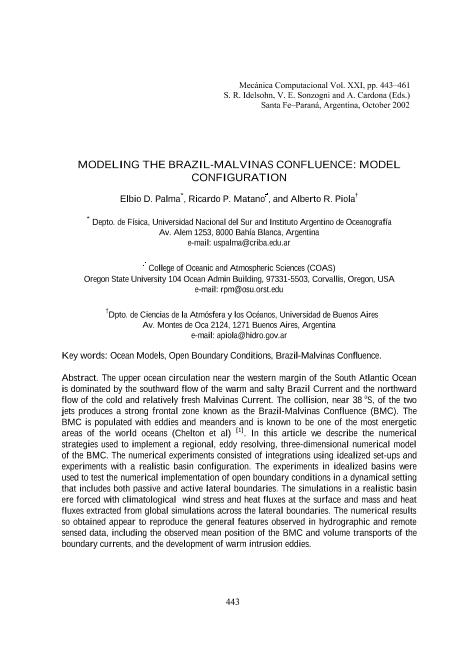Mostrar el registro sencillo del ítem
dc.contributor.author
Palma, Elbio Daniel

dc.contributor.author
Matano, Ricardo

dc.contributor.author
Piola, Alberto Ricardo

dc.date.available
2018-02-08T21:23:59Z
dc.date.issued
2002-10
dc.identifier.citation
Palma, Elbio Daniel; Matano, Ricardo; Piola, Alberto Ricardo; Modeling the Brazil ?Malvinas Confluence: Model Configuration; Asociación Argentina de Mecánica Computacional; Mecánica Computacional; XXI; 5; 10-2002; 443-461
dc.identifier.issn
2591-3522
dc.identifier.uri
http://hdl.handle.net/11336/36253
dc.description.abstract
The upper ocean circulation near the western margin of the South Atlantic Ocean is dominated by the southward flow of the warm and salty Brazil Current and the northward flow of the cold and relatively fresh Malvinas Current. The collision, near 38 o S, of the two jets produces a strong frontal zone known as the Brazil-Malvinas Confluence (BMC). The BMC is populated with eddies and meanders and is known to be one of the most energetic areas of the world oceans (Chelton et al) [1] . In this article we describe the numerical strategies used to implement a regional, eddy resolving, three-dimensional numerical model of the BMC. The numerical experiments consisted of integrations using idealized set-ups and experiments with a realistic basin configuration. The experiments in idealized basins were used to test the numerical implementation of open boundary conditions in a dynamical setting that includes both passive and active lateral boundaries. The simulations in a realistic basin ere forced with climatological wind stress and heat fluxes at the surface and mass and heat fluxes extracted from global simulations across the lateral boundaries. The numerical results so obtained appear to reproduce the general features observed in hydrographic and remote sensed data, including the observed mean position of the BMC and volume transports of the boundary currents, and the development of warm intrusion eddies.
dc.format
application/pdf
dc.language.iso
eng
dc.publisher
Asociación Argentina de Mecánica Computacional
dc.rights
info:eu-repo/semantics/openAccess
dc.rights.uri
https://creativecommons.org/licenses/by-nc-sa/2.5/ar/
dc.subject
Ocean Models
dc.subject
Open Boundary Conditions
dc.subject
Brazil-Malvinas Confluence
dc.subject.classification
Meteorología y Ciencias Atmosféricas

dc.subject.classification
Ciencias de la Tierra y relacionadas con el Medio Ambiente

dc.subject.classification
CIENCIAS NATURALES Y EXACTAS

dc.title
Modeling the Brazil ?Malvinas Confluence: Model Configuration
dc.type
info:eu-repo/semantics/article
dc.type
info:ar-repo/semantics/artículo
dc.type
info:eu-repo/semantics/publishedVersion
dc.date.updated
2017-12-12T19:35:14Z
dc.journal.volume
XXI
dc.journal.number
5
dc.journal.pagination
443-461
dc.journal.pais
Argentina

dc.journal.ciudad
Santa Fé
dc.description.fil
Fil: Palma, Elbio Daniel. Consejo Nacional de Investigaciones Científicas y Técnicas. Centro Científico Tecnológico Conicet - Bahía Blanca. Instituto Argentino de Oceanografía. Universidad Nacional del Sur. Instituto Argentino de Oceanografía; Argentina. Universidad Nacional del Sur. Departamento de Física; Argentina
dc.description.fil
Fil: Matano, Ricardo. State University of Oregon; Estados Unidos
dc.description.fil
Fil: Piola, Alberto Ricardo. Universidad de Buenos Aires. Facultad de Ciencias Exactas y Naturales. Departamento de Ciencias de la Atmósfera y los Océanos; Argentina
dc.journal.title
Mecánica Computacional

dc.relation.alternativeid
info:eu-repo/semantics/altIdentifier/url/http://www.cimec.org.ar/ojs/index.php/mc/article/viewFile/902
Archivos asociados
